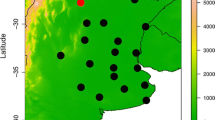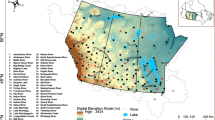Abstract
We present a multi-site stochastic model for the generation of average daily temperature, which includes a flexible parametric distribution and a multivariate autoregressive process. Different versions of this model are applied to a set of 26 stations located in Switzerland. The importance of specific statistical characteristics of the model (seasonality, marginal distributions of standardized temperature, spatial and temporal dependence) is discussed. In particular, the proposed marginal distribution is shown to improve the reproduction of extreme temperatures (minima and maxima). We also demonstrate that the frequency and duration of cold spells and heat waves are dramatically underestimated when the autocorrelation of temperature is not taken into account in the model. An adequate representation of these characteristics can be crucial depending on the field of application, and we discuss potential implications in different contexts (agriculture, forestry, hydrology, human health).











Similar content being viewed by others
References
Analitis A, Katsouyanni K, Biggeri A, Baccini M, Forsberg B, Bisanti L, Kirchmayer U, Ballester F, Cadum E, Goodman PG, Hojs A, Sunyer J, Tiittanen P, Michelozzi P (2008) Effects of cold weather on mortality: results from 15 European cities within the PHEWE project. Am J Epidemiol 168(12):1397–1408
Apipattanavis S, Podestá G, Rajagopalan B, Katz RW (2007) A semiparametric multivariate and multisite weather generator. Water Resour Res 43(11):W11401
Asong ZE, Khaliq MN, Wheater HS (2016) Multisite multivariate modeling of daily precipitation and temperature in the Canadian Prairie Provinces using generalized linear models. Clim Dyn 47(9-10):2901–2921
Augspurger CK (2013) Reconstructing patterns of temperature, phenology, and frost damage over 124 years: spring damage risk is increasing. Ecology 94(1):41–50
Baigorria GA (2014) Stochastic models to generate geospatial-, temporal-, and cross-correlated daily maximum and minimum temperatures. Adv Meteorol 2014:14
Bárdossy A, Pegram GGS (2009) Copula based multisite model for daily precipitation simulation. Hydrol Earth Syst Sci 13(12):2299–2314
Boumans RJM, Phillips DL, Victery W, Fontaine TD (2014) Developing a model for effects of climate change on human health and health—environment interactions: heat stress in Austin, Texas. Urban Climate 8:78–99
Breinl K, Turkington T, Stowasser M (2015) Simulating daily precipitation and temperature: a weather generation framework for assessing hydrometeorological hazards. Meteorol Appl 22(3):334–347
Chandler RE (2016) Rglimclim: a multisite, multivariate weather generator based on generalized linear models. R package version 1.3-0. http://www.ucl.ac.uk/~ucakarc/work/glimclim.html
Chandler RE, Wheater HS (2002) Analysis of rainfall variability using generalized linear models: a case study from the west of Ireland. Water Resour Res 38(10):1192
Chen J, Brissette FP, Zhang JX (2014) A multi-site stochastic weather generator for daily precipitation and temperature. Trans ASABE 57(5):1375–1391
Deryng D, Conway D, Ramankutty N, Price J, Warren R (2014) Global crop yield response to extreme heat stress under multiple climate change futures. Environ Res Lett 9(3):034011
Erhardt TM, Czado C, Schepsmeier U (2015) R-vine models for spatial time series with an application to daily mean temperature. Biometrics 71(2):323–332
Evin G, Favre A-C, Hingray B (2018) Stochastic generation of multi-site daily precipitation focusing on extreme events. Hydrol Earth Syst Sci 22(1):655–672. https://doi.org/10.5194/hess-22-655-2018
Fernandez C, Steel MFJ (1998) On Bayesian modeling of fat tails and skewness. J Am Stat Assoc 93 (441):359–371
Frei C (2014) Interpolation of temperature in a mountainous region using nonlinear profiles and non-Euclidean distances. Int J Climatol 34(5):1585–1605
Guenet B, Cadule P, Zaehle S, Piao SL, Peylin P, Maignan F, Ciais P, Friedlingstein P (2013) Does the integration of the dynamic nitrogen cycle in a terrestrial biosphere model improve the long-term trend of the leaf area index Clim Dyn 40(9-10):2535–2548
Gutschick VP, BassiriRad H (2003) Extreme events as shaping physiology, ecology, and evolution of plants: toward a unified definition and evaluation of their consequences. New Phytol 160(1):21–42
Hatfield JL, Prueger JH (2015) Temperature extremes: effect on plant growth and development. Weather Clim Extremes 10:4–10
IPCC (2014) Climate change 2014: synthesis report. Contribution of Working Groups I, II and III to the Fifth Assessment Report of the Intergovernmental Panel on Climate Change. Core Writing Team, R.K. Pachauri and L.A. Meyer (eds.), IPCC, Geneva, Switzerland. 151pp
King LM, McLeod AI, Simonovic SP (2014) Simulation of historical temperatures using a multi-site, multivariate block resampling algorithm with perturbation. Hydrol Process 28(3):905–912
King LM, McLeod AI, Simonovic SP (2015) Improved weather generator algorithm for multisite simulation of precipitation and temperature. JAWRA J Am Water Resour Assoc 51(5):1305–1320
Krinner G, Viovy N, de Noblet-Ducoudré N, Ogée J, Polcher J, Friedlingstein P, Ciais P, Sitch S, Prentice IC (2005) A dynamic global vegetation model for studies of the coupled atmosphere-biosphere system. Glob Biogeochem Cycles 19(1):GB1015
Kucharik CJ, Foley JA, Delire C, Fisher VA, Coe MT, Lenters JD, Young-Molling C, Ramankutty N, Norman JM, Gower ST (2000) Testing the performance of a dynamic global ecosystem model: water balance, carbon balance, and vegetation structure. Glob Biogeochem Cycles 14(3):795–825
Lamb R, Faulkner D, Wass P, Cameron D (2016) Have applications of continuous rainfall—runoff simulation realized the vision for process-based flood frequency analysis Hydrol Process 30(14): 2463–2481
Leander R, Buishand TA (2009) A daily weather generator based on a two-stage resampling algorithm. J Hydrol 374(3–4):185–195
Li Z (2014) A new framework for multi-site weather generator: a two-stage model combining a parametric method with a distribution-free shuffle procedure. Clim Dyn 43(3-4):657–669
Luedeling E (2012) Climate change impacts on winter chill for temperate fruit and nut production: a review. Sci Hortic 144:218–229
Matalas NC (1967) Mathematical assessment of synthetic hydrology. Water Resour Res 3(4):937–945
Mezghani A, Hingray B (2009) A combined downscaling-disaggregation weather generator for stochastic generation of multisite hourly weather variables over complex terrain: development and multi-scale validation for the Upper Rhone River basin. J Hydrol 377(3–4):245–260
Ouzeau G, Soubeyroux JM, Schneider M, Vautard R, Planton S (2016) Heat waves analysis over France in present and future climate: Application of a new method on the EURO-CORDEX ensemble. Climate Services 4:1–12
Rasmussen PF (2013) Multisite precipitation generation using a latent autoregressive model. Water Resour Res 49(4):1845–1857
Rebonato R, Jaeckel P (2011) The most general methodology to create a valid correlation matrix for risk management and option pricing purposes. SSRN Scholarly Paper ID 1969689. Social Science Research Network, Rochester
Richardson CW (1981) Stochastic simulation of daily precipitation, temperature, and solar radiation. Water Resour Res 17(1):182–190
Robine J-M, Cheung SLK, Le Roy S, Van Oyen H, Griffiths C, Michel J-P, Herrmann FR (2008) Death toll exceeded 70,000 in Europe during the summer of 2003. C R Biol 331(2):171–178
Romero CC, Dukes MD, Baigorria GA, Cohen R (2009) Comparing theoretical irrigation requirement and actual irrigation for citrus in Florida. Agric Water Manag 96(3):473–483
Rousseeuw PJ, Molenberghs G (1993) Transformation of non positive semidefinite correlation matrices. Communications in Statistics - Theory and Methods 22(4):965–984
Schoups G, Vrugt JA (2010) A formal likelihood function for parameter and predictive inference of hydrologic models with correlated, heteroscedastic, and non-Gaussian errors. Water Resour Res 46(10):W10531
Steinschneider S, Brown C (2013) A semiparametric multivariate, multisite weather generator with low-frequency variability for use in climate risk assessments. Water Resour Res 49(11):7205–7220
Stöckle CO, Donatelli M, Nelson R (2003) CropSyst, a cropping systems simulation model. Eur J Agron 18(3–4):289–307
Wilks DS (1998) Multisite generalization of a daily stochastic precipitation generation model. J Hydrol 210 (1–4):178–191
Wilks DS (1999) Simultaneous stochastic simulation of daily precipitation, temperature and solar radiation at multiple sites in complex terrain. Agric For Meteorol 96(1–3):85–101
Wilks DS (2009) A gridded multisite weather generator and synchronization to observed weather data. Water Resour Res 45(10):W10419
Wilks DS, Wilby RL (1999) The weather generation game: a review of stochastic weather models. Prog Phys Geogr 23(3):329–357
Yang Y, Liu DL, Anwar MR, Zuo H, Yang Y (2014) Impact of future climate change on wheat production in relation to plant-available water capacity in a semiarid environment. Theor Appl Climatol 115(3-4):391–410
Zuo J, Pullen S, Palmer J, Bennetts H, Chileshe N, Ma T (2015) Impacts of heat waves and corresponding measures: a review. J Clean Prod 92:1–12
Funding
Financial support for this study by the Swiss Federal Office for Environment (FOEN), the Swiss Federal Nuclear Safety Inspectorate (ENSI), the Federal Office for Civil Protection (FOCP), and the Federal Office of Meteorology and Climatology, MeteoSwiss, through the project EXAR (“Evaluation of extreme Flooding Events within the Aare-Rhine hydrological system in Switzerland”), is gratefully acknowledged.
Author information
Authors and Affiliations
Corresponding author
Appendix A: Skew exponential distribution
Appendix A: Skew exponential distribution
The exponential power (EP) distribution, also known as the generalized error distribution, is a generalization of the normal distribution. A shape parameter, ν > 0, leads to tails that are either heavier than normal if ν < 2 or lighter if ν > 2, and ν = 2 corresponds to the normal case. For a standardized variate z (with a mean of 0 and a standard deviation of 1), its probability density is defined as
with
The skew exponential power (SEP) distribution is a generalization of the EP distribution. An additional shape parameter, ξ, can lead to different skewness when it differs from 1. For a normalized variate z and parameters ν > 0 and ξ > 0, the probability density of the SEP distribution is defined as
with
Rights and permissions
About this article
Cite this article
Evin, G., Favre, AC. & Hingray, B. Stochastic generators of multi-site daily temperature: comparison of performances in various applications. Theor Appl Climatol 135, 811–824 (2019). https://doi.org/10.1007/s00704-018-2404-x
Received:
Accepted:
Published:
Issue Date:
DOI: https://doi.org/10.1007/s00704-018-2404-x




